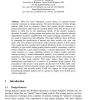Free Online Productivity Tools
i2Speak
i2Symbol
i2OCR
iTex2Img
iWeb2Print
iWeb2Shot
i2Type
iPdf2Split
iPdf2Merge
i2Bopomofo
i2Arabic
i2Style
i2Image
i2PDF
iLatex2Rtf
Sci2ools
97
Voted
ECOOP
1998
Springer
1998
Springer
Precise Visual Specification of Design Patterns
There has been substantial recent interest in captured design expertise expressed as design patterns. Prevalent descriptions of these design patterns suffer from two demerits. Firstly, they capture specific instances of pattern deployment, rather than the essential pattern itself, thus the spirit of the pattern is often lost in the superfluous details of the specific instances described. Secondly, existing pattern descriptions rely upon relatively informal diagrammatic notations supplemented with natural language annotations. This can result in imprecision and ambiguity. This paper addresses these problems by separating the specification of patterns into three models (role, type, and The most abstract (role-centric) model presents patterns in their purest form, capturing their essential spirit without deleterious detail. A role-model is refined by a type-model (adding usually-domain-specific constraints), which is further refined by a class-model (forming a concrete deployment). We uti...
Related Content
| Added | 05 Aug 2010 |
| Updated | 05 Aug 2010 |
| Type | Conference |
| Year | 1998 |
| Where | ECOOP |
| Authors | Anthony Lauder, Stuart Kent |
Comments (0)

